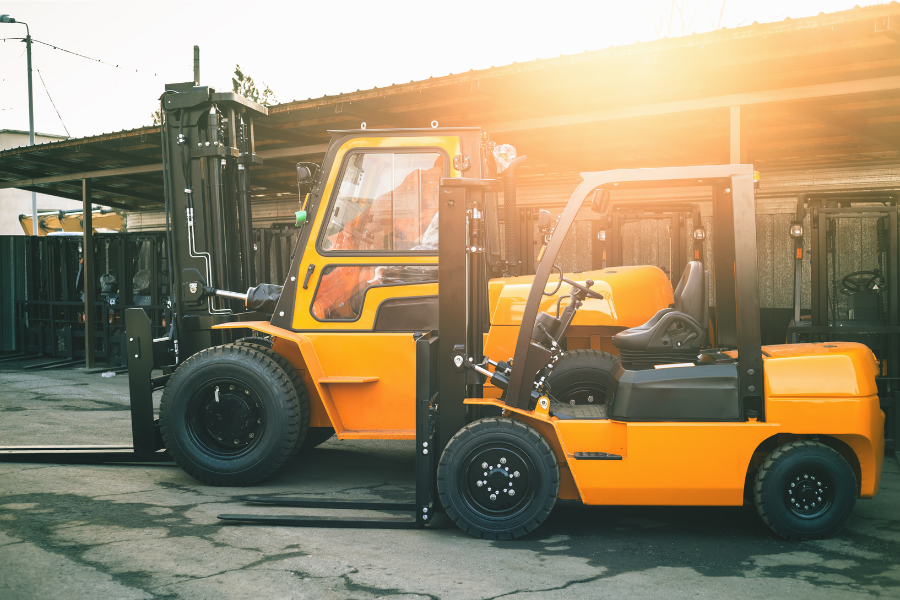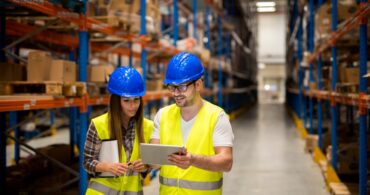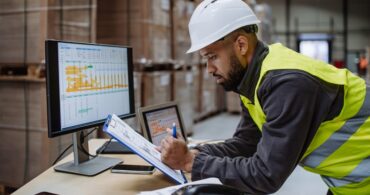Counterbalance lifts are one of the most popular and useful industrial trucks. They are essential to warehouses and distribution centers across the world. In addition to performing impressive lifting feats every day, counterbalanced forklifts are also a marvel of engineering.
What is counterbalance?
Counterbalancing is something you do every day. Counterbalancing simply means to offset with something that has an equal but opposite effect. For example, if your food is too bland, you may counterbalance it by adding some salt. If a cup of coffee is too bitter, you may add some sugar.
Counterbalancing with mechanical items is similar. For example, many products with heavy doors, use a counterbalanced hinge. A car’s trunk is made from the same heavy metals as the rest of the vehicle, but it can be opened (and stay open) with ease. The reason is due to the counterbalanced hinge (likely with spring assist) that dramatically reduces the force needed to open the trunk.
How a forklift works
Typically, if you see an industrial truck prowling a warehouse or distribution center it’s an electric counterbalanced forklift. Even though most forklifts are extremely heavy, they are still at risk of tipping over as they lift a heavy load (by the way, if you need to know a forklift’s maximum weight capacity, the information is printed on the data plate).
To offset the risk of tipping over, a counterbalance electric forklift is constructed with heavy weights in the rear of the vehicle (including the large battery that powers the vehicle). It’s this rear forklift counterweight weight that helps offset the cargo’s mass as the vehicle lifts it.
An electric counterbalanced forklift has a three-point suspension system that helps distribute the vehicle’s weight. Two of these three points are the front tires, which are connected to the front axle. The third point, known as the pivot point, is located between the rear wheels on the back axle. If you imagine lines “connecting” these three points, you create an area known as the stability triangle.
When a forklift is not carrying a load, its center of gravity is in the middle of the stability triangle. However, once the tines pick up a load and begin the rise, the center of gravity moves toward the front of the vehicle. The higher the tines, the more the center of gravity moves toward the front axle (the edge of the stability triangle). If the center of gravity remains within the boundaries of the stability triangle, the vehicle is secure. However, once the center of gravity passes outside the stability triangle, the forklift is at risk of tipping over.
In an electric forklift counterbalance is created by the weights in the rear of the vehicle, which helps to ensure that the center of gravity remains inside the stability triangle.
Are there propane counterbalanced forklifts?
So far, this article has focused on an electric counterbalanced forklift, but there are models of these industrial trucks powered by other means of propulsion, such as a propane counterbalance truck.
A propane counterbalance forklift is not as common as its electric brethren for one primary reason: exhaust. Gas-powered vehicles emit fumes that can be hazardous to people, especially in confined spaces. Since many counterbalanced forklifts operate inside warehouses, they tend to be powered by electric batteries because electric vehicles do not emit dangerous vapors. For a propane counterbalance truck to operate inside a warehouse, the building must have plenty of open space and an exceptional ventilation system (and even then, an electric vehicle is the safer choice). Also, when a vehicle is operated by propane, a significant quantity of the gas must be stored on-site, which can create another risky situation for workers.
So, a propane counterbalance forklift typically operates outdoors, where its exhaust is less dangerous to workers. However, this type of worksite tends to add another complication to a counterbalanced truck: uneven terrain.
Because the stability triangle is comprised of a vehicle’s wheels and axles, those components should remain on level ground. When the vehicle is on an incline or one wheel is at a different elevation than the others (for example, in a pothole or on a rock), the vehicle’s center of gravity shifts. For this reason, many outdoor vehicles use another method for stabilization: outriggers.
What is an outrigger forklift?
Due to uneven terrain, exceptionally heavy loads and extreme distances or heights that many outdoor industrial trucks deal with daily, they cannot rely on counterbalance to stabilize the vehicle.
Instead, these vehicles use stabilizing legs, which are also known as outriggers or base legs, to create a secure foundation when lifting loads. These components provide support that prevents movement and helps keep the machine from tipping over without the need for a counterbalance weight.
An example of an outdoor vehicle that utilizes outriggers is a telehandler. A telehandler utilizes an extendable boom that’s capable of vertical and lateral movement, and some machines can lift as high as 50 feet. A counterbalanced forklift could never handle those extreme movements. So, before lifting anything, the machine locks itself in place with outriggers.
Some indoor vehicles also utilize outriggers. For example, a reach truck is too small to utilize counterbalancing. The design of the vehicle can’t accommodate heavy counterweights. Instead, a reach truck has two stabilizing outriggers that extend parallel to its forks. The outriggers create a secure base that prevents the machine from tipping forward while lifting a load.
Reach trucks, like most indoor industrial vehicles, are powered by electric batteries. Whether you’re using an electric reach truck, electric counterbalanced forklift or another indoor industrial truck, you need the best batteries for your vehicles and their needs. That’s where Texas Motive Solutions shines.
We offer a complimentary forklift fleet performance analysis that is guaranteed to optimize the performance of your fleet. We also provide top-of-the-line forklift batteries and accessories to fit your needs. Please reach out to (888) 316-2459 or fill out this form and learn about our services to discover everything that Texas Motive Solutions can do for you.



